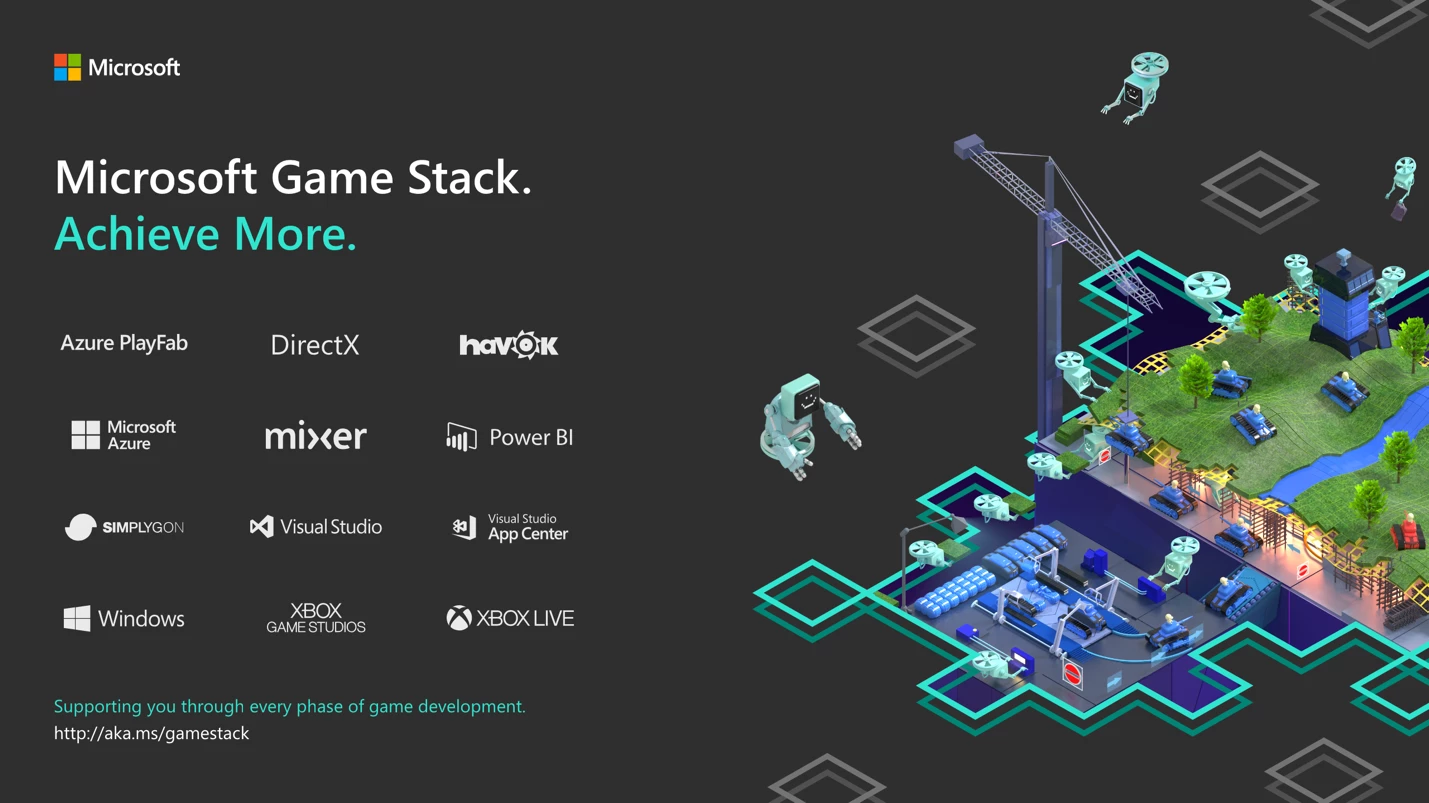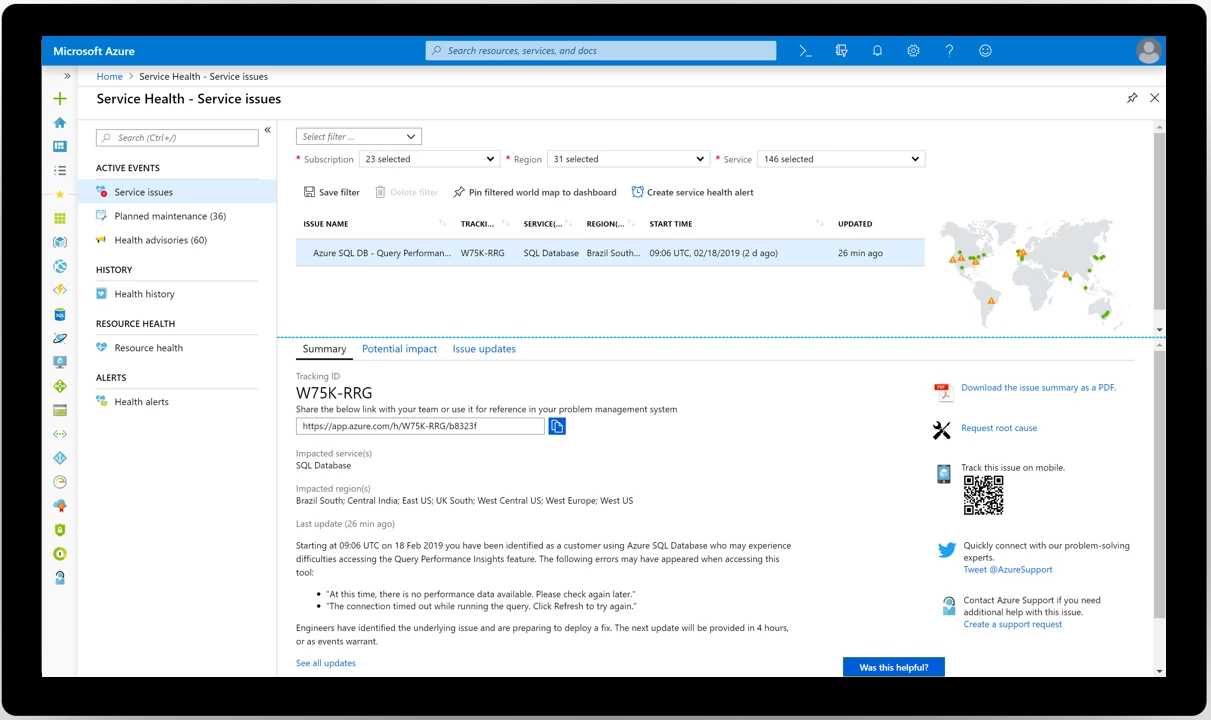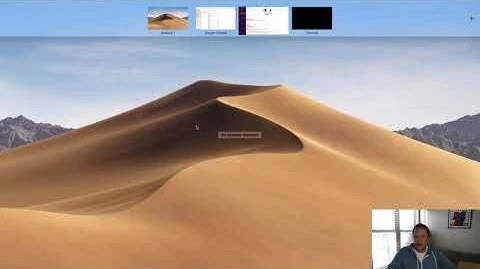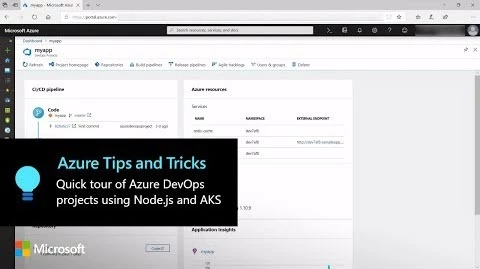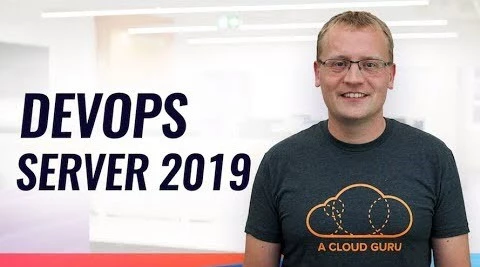Azure Data Box, Migration, Storage, Storage Explorer
Azure.Source – Volume 74
Posted on
14 min read
Now in preview
AzCopy support in Azure Storage Explorer now available in public preview
AzCopy in Azure Storage Explorer is now in public preview. AzCopy is a popular command-line utility that provides performant data transfer into and out of a storage account. AzCopy enhances the performance and reliability through a scalable design, where concurrency is scaled up according to the number of machine’s logical cores. Azure Storage Explorer provides the UI interface for various storage tasks, and now it supports using AzCopy as a transfer engine to provide the highest throughput for transferring your files for Azure Storage. This capability is available today as a preview in Azure Storage Explorer.
Now available for preview: Workload importance for Azure SQL Data Warehouse
Announcing the preview of Workload Importance for Azure SQL Data Warehouse on the Gen2 platform. Manage resources more efficiently with Azure SQL Data Warehouse – a fast, flexible and secure analytics platform for enterprises of all sizes. Workload importance gives data engineers the ability to use importance to classify requests. Requests with higher importance are guaranteed quicker access to resources which helps meet SLAs.
Also available in preview
- Public preview: Azure Log Analytics in France Central, Korea Central, North Europe
- Public preview: Adaptive network hardening in Azure Security Center
- Update 19.03 for Azure Sphere public preview now available for evaluation
- Azure Security Center: Regulatory compliance dashboard in public preview
News and updates
Achieve more with Microsoft Game Stack
Announcing Microsoft Game Stack, a new initiative in which we commit to bringing together Microsoft tools and services that empower game developers to achieve more. Game Stack brings together all of our game-development platforms, tools, and services—such as Azure, PlayFab, DirectX, Visual Studio, Xbox Live, App Center, and Havok—into a robust ecosystem that any game developer can use. The goal of Game Stack is to help you easily discover the tools and services you need to create and operate your game.
Azure Databricks – VNet injection, DevOps Version Control and Delta availability
Azure Databricks provides a fast, easy, and collaborative Apache® Spark™-based analytics platform to accelerate and simplify the process of building big data and AI solutions that drive the business forward, all backed by industry-leading SLAs. With Azure Databricks, you can set up your Spark environment in minutes and auto-scale quickly and easily. You can also apply your existing skills and collaborate on shared projects in an interactive workspace with support for Python, Scala, R, and SQL, as well as data science frameworks and libraries like TensorFlow and PyTorch.
Hardware innovation for data growth challenges at cloud-scale
Last week we at Open Compute Project (OCP) Global Summit 2019 Microsoft announced Project Zipline: a cutting-edge compression algorithm and optimized hardware implementation for the types of data we see in our cloud storage workloads. By engineering innovation at the systems level, we've been able to simultaneously achieve higher compression ratios, higher throughput, and lower latency than the other algorithms that are currently available. We are open sourcing Project Zipline compression algorithms, hardware design specifications, and Verilog source code for register transfer language (RTL) with initial content available today and more coming soon.
Azure Data Box family now enables import to Managed Disks
Announcing support for managed disks is now available across the Azure Data Box family of devices, which includes Data Box, Data Box Disk, and Data Box Heavy. The Azure Data Box offline family lets you transfer hundreds of terabytes of data to Microsoft Azure in a quick, inexpensive, and reliable manner. With managed disks support on Data Box, you can now move your on-premises virtual hard disks (VHDs) as managed disks in Azure with one simple step.
Simplify disaster recovery with Managed Disks for VMware and physical servers
Azure Site Recovery (ASR) now supports disaster recovery of VMware virtual machines and physical servers by directly replicating to Managed Disks. To enable replication for a machine, you no longer need to create storage accounts because you can now write replication data directly to a type of Managed Disk. This change will not impact the machines which are already in a protected state; however, all new protections will now have this capability available on the Azure portal.
Simplifying your environment setup while meeting compliance needs with built-in Azure Blueprints
Announcing the release of our first Azure Blueprint built specifically for a compliance standard, the ISO 27001 Shared Services blueprint sample, which maps a set of foundational Azure infrastructure such as virtual networks and policies, to specific ISO controls. Azure Blueprints is a free service that helps customers deploy and update cloud environments in a repeatable manner using composable artifacts such as policies, deployment templates, and role-based access controls. This service is built to help customers set up governed Azure environments and can scale to support production implementations for large-scale migrations. The ISO 27001 Shared Services Blueprint is already available to your Azure tenant.
Microsoft Azure portal March 2019 update
This month’s updates include an improved “All services” view, Virtual Network Gateway overview updates, an improved DNS Zone and Load Balancer creation experience, Management Group integration into Activity Log, redesigned overview screens for certain services within Azure DB, an improved creation experience for Azure SQL Database, multiple changes to the Security Center, and more updates to Intune. Sign in to the Azure portal now and see for yourself everything that’s new.
Approve Azure Pipelines deployments from Slack
Approve Azure Pipelines deployments from Slack is now available. We’re making it even easier for you, with a tighter integration that lets you be more productive – even when you’re on the go. Approving release deployments in Azure Pipelines is just a click away.
Azure Service Fabric 6.4 Refresh Release
Updates to the .NET SDK, Java SDK and Service Fabric runtimes are rolling out through Web Platform Installer, NuGet packages and Maven repositories in all regions.
Azure Security Center updates
- Support for virtual network peering in Azure Security Center
- Azure Security Center adaptive application control updates
- Azure Security Center: Secure score impact changes
- Azure Security Center policy migration to Azure Policy
- Azure Security Center update: Secure score for compliance metrics
- Azure Security Center update: Azure App Service recommendation improvements
Additional news and updates
- Azure Log Analytics is now General Available in Australia East and in Australia Central
- Service Map available in Central Canada and UK South
- Application Insights is now available in France Central and Korea Central
- Upcoming change to Azure Monitor Application Insights Smart Detection emails
- Azure Resource Manager template language additions
Technical content
Run your code and leave build to us
Getting your app to the cloud is more work than you may anticipate. We're happy to share that there is a faster way. When you need to focus on app code, you can delegate build and deployment to Azure with App Service web apps and we'll take care of building and running your code the way you expect.
Stay informed about service issues with Azure Service Health
Azure Service Health helps you stay informed and take action when Azure service issues like incidents and planned maintenance affect you by providing a personalized health dashboard, customizable alerts, and expert guidance. Read how you can use Azure Service Health’s personalized dashboard to stay informed about issues that could affect you now or in the future.
Azure Stack IaaS – part four
Deploying your IaaS VM-based applications to Azure and Azure Stack requires a comprehensive evaluation of your BC/DR strategy. “Business as usual” is not enough in the context of cloud. For Azure Stack, you need to evaluate the resiliency, availability, and recoverability requirements of the applications separate from the protection schemes for the underlying infrastructure. Learn the concepts and best practices to protect your IaaS virtual machines (VMs) on Azure Stack.
Create a transit VNet using VNet peering
Azure Virtual Network (VNet) is the fundamental building block for any customer network. VNet lets you create your own private space in Azure, or as I call it your own network bubble. VNets are crucial to your cloud network as they offer isolation, segmentation, and other key benefits. VNet peering with gateway transit works across classic Azure Service Management (ASM) and Azure Resource Manager (ARM) deployment models and works across subscriptions and subscriptions belonging to different Azure Active Directory tenants. Gateway transit has been available since September 2016 for VNet peering in all regions and will be available for global VNet peering shortly.
Commit, push, deploy — Git in the Microsoft Azure Cloud
Git is a popular Version Control option — and, instead of asking you to learn something new, this article serves as an introduction to help Git users get familiar with cloud (and Azure), including an end-to-end walkthrough. Chris covers how to download, run, and configure a sample app using Git, and from there, dives into how to deploy, manage, update, and redeploy that app inside Azure.
Azure DevOps Slack Integration
In this quick how-to video, Neil shows how easy it is to setup the Azure DevOps and Slack integration for detailed real-time notifications about your build and release notifications. You'll see how to customize what you see, and click through to Azure DevOps to dig into build failures, approve requests, and validate successful deploys.
Azure Functions With F#
This quick post from Aaron Powell walks through how to use VS Code and F# to create Azure Functions v2.
How to query Azure resources using the Azure CLI
The Azure CLI can be used to not only create, configure, and delete resources from Azure — but also to query data from Azure. Querying Azure for resource properties is handy when you're writing scripts using the Azure CLI – for instance, when you want to get an Azure Virtual Machine or Container Instance IP address to perform some action on that resource. This post is a quick exercise that demonstrates several concepts, so you're ready to query a single resource property and store the value of that property in a variable. We'll use Azure Container Instances (ACI), but you don't need to have experience with ACI to complete the steps in this article – the concepts transfer to any Azure resource.
7 things you should know when getting started with Serverless APIs
In this article—based on a talk Simona Cotin gave at Build— she walks you through an existing application with an Express back-end and porting it to a Serverless back-end by changing a single line in our front-end code. By the end of the article, you will have built an API that will scale instantly as more and more users come in and our workload increases.
Additional technical content
- Identify log write limits on Azure SQL Managed Instance using QPI library
- Enhance data protection and compliance with customer managed keys
- Running Azure Cosmos DB queries from SQL Server using ODBC driver
- Planning the future for NoSQL Cassandra DB Applications on Azure
- SAP on Azure High Availability Systems with Heterogenous Windows and Linux Clustering and SAP HANA
- Lesson Learned #79: Connecting to Azure SQL Database just using the port 1433 without redirection
Azure shows
Episode 270 – Hammer and Nail | The Azure Podcast
Cale Teeter and Sujit D'Mello discuss using a solutions-based approach when selecting Azure services instead of getting caught in the hype of new services.
Heat Maps and Image Overlays in Azure Maps | Internet of Things Show
Heat maps are used to represent the density of data using a range of colors. They are often used to show the data “hot spots” on a map and are great to help understand data. The heat map layer also supports weighted data points to help bring the most relevant information to the surface. Learn about the heat map and image layer visualizations in side of Azure Maps.
What’s New for Visual Studio 2019 Integrations with Azure Boards | The DevOps Lab
In this episode, you see a quick walk through of a new experience in Visual Studio 2019; showing how a developer can quickly find the work they need and associate it to their pending changes.
Azure Pipelines multi-cloud support and integration with DevOps tools | Azure Friday
Learn to integrate Azure Pipelines with various 3rd-party tools to achieve full DevOps cycle with Multi-cloud support. You can continue to use you existing tools and get Azure Pipelines benefits: application release orchestration, deployment, approvals, and full traceability all the way to the code or issue.
Five Ways You Can Infuse AI into Your Applications | Five Things
Leben Things! In case you don't speak Elvish, that roughly translates to “Five Things”. This week I sit down with Noelle LaCharite from the Microsoft Cognitive Services team to learn how machines can translate language, perform search on unstructured data, converse like humans and more. Even better, you can use this stuff in your applications right away; no degree in multi-dimensional calculus required. This is five ways that you can infuse AI into your applications today.
Getting Started with Infrastructure as Code (IaC) | The Open Source Show
Armon Dadgar, HashiCorp CTO and co-founder, and Aaron Schlesinger walk us through the core concepts of Infrastructure as Code (IaC) and how it goes beyond what people typically think when they hear “Infrastructure.” They break down the what, when, how, and why IaC makes developers' lives easier, whether you're running a simple application or have a complex, multi-node system. You'll learn how you can use HashiCorp Terraform to get up and running with IaC, going from nothing to a complete carbon copy of your production environment at the click of button (read: you focus on building, testing, and deploying, not spinning up test environments and hoping they're close to what's in production).
Quick tour of Azure DevOps projects using Node.js and AKS: Part 2 | Azure Tips and Tricks
Learn what Azure DevOps projects are and how to use them with Node.js and Azure Kubernetes Service. In part 2, you’ll get to explore the rest of the resources that Azure DevOps projects has to offer.
How to create a storage account and upload a blob | Azure Portal Series
The Azure Portal enables you to create and manage storage accounts and upload a blob. In this video of the Azure Portal “How To” Series, learn how to easily create a storage account, upload a blob, and manage the storage account within Storage Explorer (preview).
Greg Leonardo on Deploying the Azure Way | Azure DevOps Podcast
Greg Leonardo is a Cloud Architect at Campus Management Corp. and Webonology. In this episode of the Azure Podcast, he discusses some of the topics from his book, Hands-On Cloud Solutions with Azure: architecting, developing, and deploying the Azure way. He also talks about working with infrastructure as code, provisioning and watching environments, and more about what developers targeting Azure need to know.
Episode 2 – WTF Azure (How Do I Get Started?) | AzureABILITY
AzureABILITY host Louis Berman discusses how to get started in Azure with his fellow Cloud Solutions Architect, Srini Ambati. Listen in as Louis and Srini give you a leg up into the cloud.
Events
Microsoft Create – A Global Startup Event Series
Create is for startup founders, technical co-founders, and early or first engineers, with potentially a small number of business-focused attendees. The event is ideally for early stage startups looking to make technical decisions about platform and technology stack. Our agenda focuses heavily on Azure technologies and highlights Microsoft for Startups offerings and the ScaleUp program. The tour is free to attendees.
Join Microsoft at the NVIDIA GPU Technology Conference
The world of computing goes deep and wide on working on issues related to our environment, economy, energy, and public health systems. These needs require modern, advanced solutions that were traditionally limited to a few organizations, are hard to scale, and take a long time to deliver. Microsoft Azure delivers High Performance Computing (HPC) capability and tools to power solutions that address these challenges integrated into a global-scale cloud platform. Microsoft’s partnership with NVIDIA makes access to NVIDIA GPUs easier than ever. This week’s NVIDIA’s GPU Technology Conference teaches Azure customers to combine the flexibility and elasticity of the cloud with the capability of NVIDIA GPUs.
Cloud Commercial Communities webinar and podcast newsletter–March 2019
Each month the Cloud Commercial Communities team focuses on core programs, updates, trends, and technologies that Microsoft partners and customers need to know to increase success using Azure and Dynamics. Make sure you catch a live webinar and participate in live QA.

IoT in Action: A more sustainable future for farming
The future of food security and feeding an expanding global population depends upon our ability to increase food production globally—an estimated 70 percent by the year 2050, according to the Food and Agriculture Organization of the United Nations. But challenges ranging from climate change, soil quality, pest control, and shrinking land availability, not to mention water resource constraints, must be addressed. We believe that the Internet of Things (IoT) technology and data-driven agriculture is one answer.
IoT in Action: Thriving partner ecosystem key to transformation
The Internet of Things (IoT) is an ongoing journey. Digital transformation requires that solutions be connected so that the data can be collected and analyzed more effectively across systems to drive exponential improvements in operations, profitability, and customer and employee loyalty. Through our partner-plus-platform-approach, we have committed $5 billion in IoT-focused investments to grow and support our partner ecosystem–specifically through unrelenting R&D innovation in critical areas, like security, new development tools and intelligent services, artificial intelligence, and emerging technologies.
Customers, partners, and industries
Spinning up cloud-scale analytics is even more compelling with Talend and Microsoft
Stich Data Loader is Talend's recent addition to its portfolio for small- and mid-market customers. With Stitch Data Loader, customers can load 5 million rows/month into Azure SQL Data Warehouse for free or scale up to an unlimited number of rows with a subscription. All across the industry, there is a rapid shift to the cloud. Using a fast, flexible, and secure cloud data warehouse is an important first step in that journey. With Microsoft Azure SQL Data Warehouse and Stitch Data Loader companies can get started faster than ever.
Economist study: OEMs create new revenue streams with next-gen supply chains
Original equipment manufacturers (OEMs) make the wheels go round for the business world. Successful OEMs are always on the lookout for opportunities to drive down costs and differentiate their brands; and the rise of IoT offers a golden opportunity to fundamentally transform the supply chain. The Economist Intelligence Unit surveyed 250 senior executives at OEMs in North America, Europe, and Asia-Pacific to gain insights from those customers at the center of the supply chain.
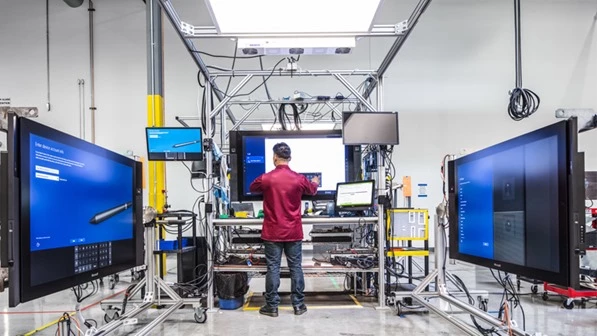
Azure Marketplace new offers – Volume 33
The Azure Marketplace is the premier destination for all your software needs – certified and optimized to run on Azure. Find, try, purchase, and provision applications & services from hundreds of leading software providers. You can also connect with Gold and Silver Microsoft Cloud Competency partners to help your adoption of Azure. In the first half of February we published 50 new offers.
Accelerating enterprise digital transformation through DevOps
IT organizations are under more pressure than ever to do more with less, they are expected to drive competitive advantage and innovation with higher quality while managing smaller teams. Organizations must now adapt by adopting rapid and strategic transformation while simultaneously working diligently to keep the lights on, and all with the important goal of reducing costs. To address these challenges, Sirrus7, GitHub, and HashiCorp have joined together to create the DevOps Acceleration Engine.
Maximize existing vision systems in quality assurance with Cognitive AI
Quality assurance matters to manufacturers. The reputation and bottom line of a company can be adversely affected if defective products are released. If a defect is not detected, and the flawed product is not removed early in the production process, the damage can run in the hundreds of dollars per unit. To mitigate this, many manufacturers install cameras to monitor their products as they move along the production line. Mariner, with its Spyglass solution, uses AI from Azure to achieve visibility over the entire line, and to prevent product defects before they become a problem.
Azure This Week – 15 March 2019 | A Cloud Guru – Azure This Week
This time on Azure This Week, Lars covers the official release of Azure DevOps Server 2019, the public preview of Azure Premium Blob Storage and he looks at some new features in Azure Firewall.

